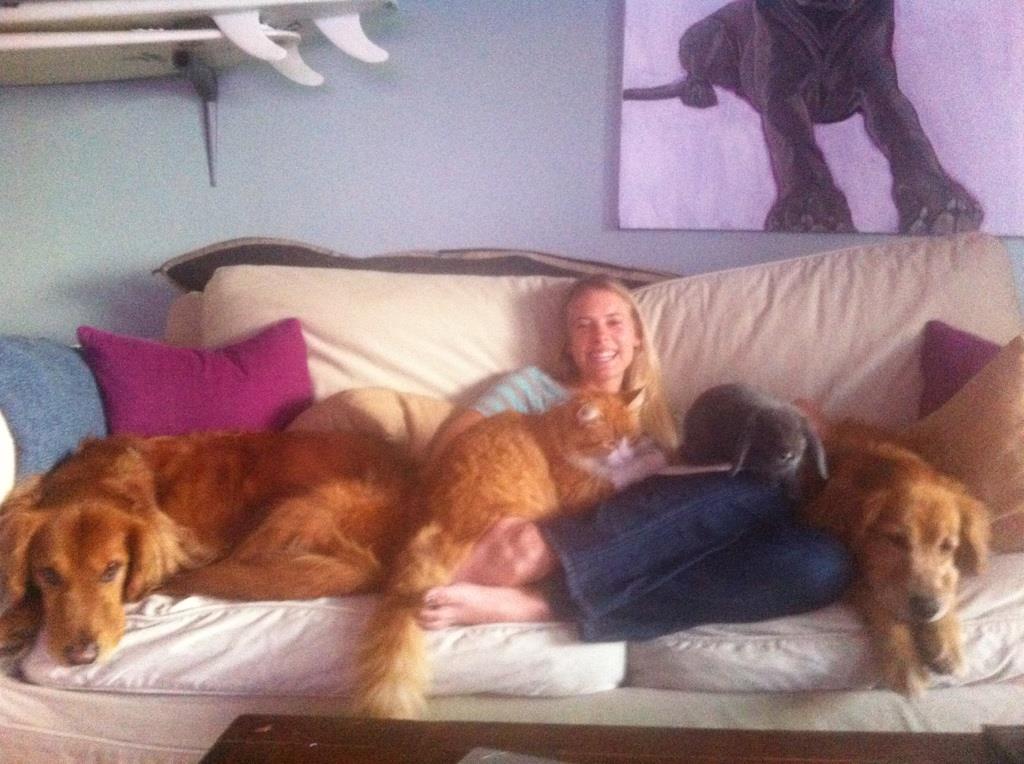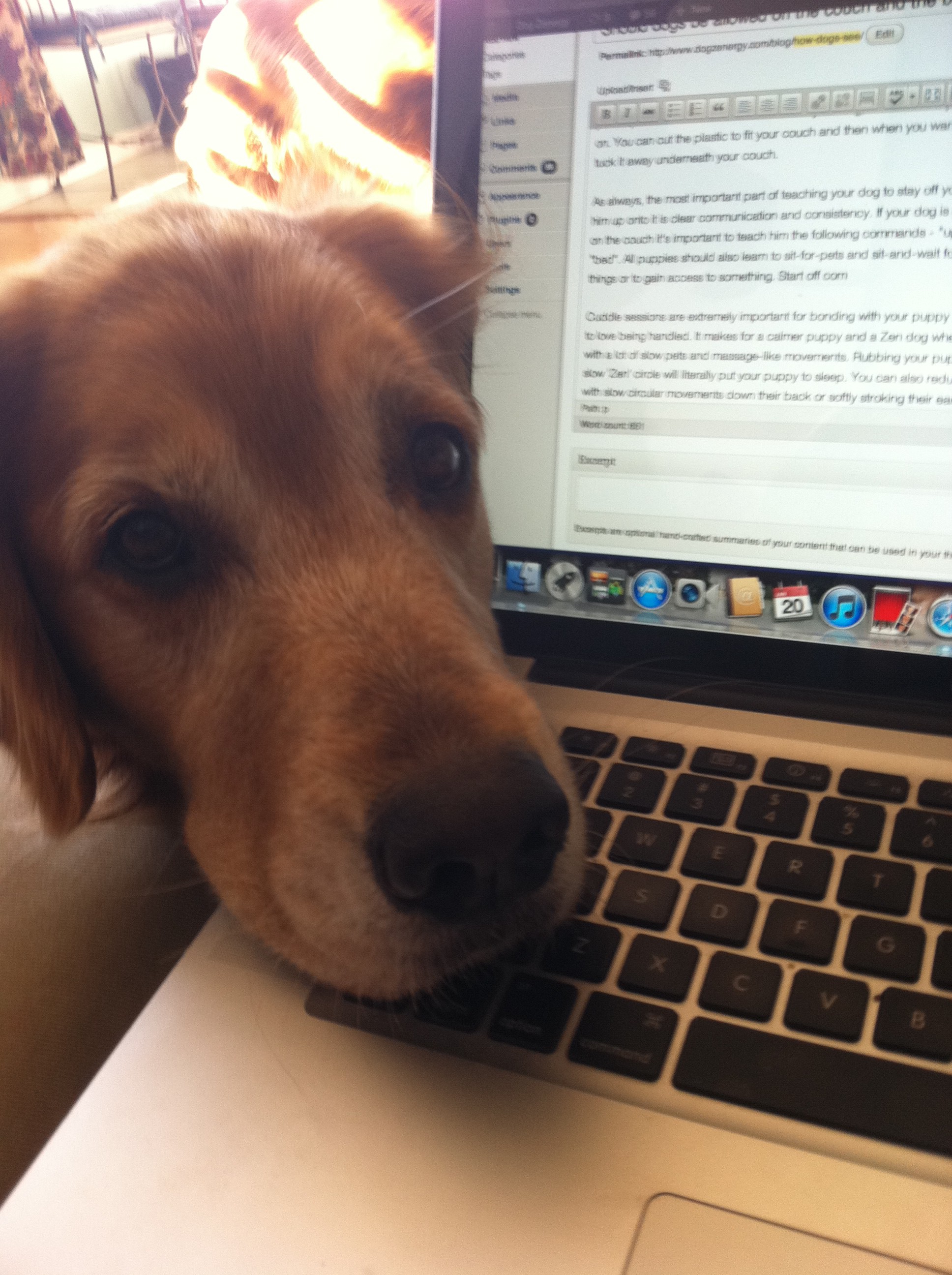As I write this post I'm sitting on my couch with my 80 lb. golden retriever, Taj, practically laying in my lap and my 60 lb. golden, Daisy, all snuggled up to me on my right. I must admit, one of my absolute, most favorite things to do in the whole entire world is snuggle with my favorite furballs.

Cuddling with all of my animals. Notice the big smile on my face! Pure happiness.
Our usual cuddle session starts with me sitting on the couch with my laptop, and then Daisy comes over and rests her head on the couch looking at me with her golden eyes asking for approval to jump up next me. I'll ask her if she wants to cuddle and her head stays on the couch while her back end starts wagging. She waits till I pat the couch twice and say, "Up, up," before she hops up and snuggles into my side. She curls up into the cutest little ball or rests her head on my lap. Then Taj slowly lumbers over with his swaying lion's gait, waits for his cue and then curls up into another ball of cuteness. To top it off, my big orange cat comes over and settles in right on my lap. Squished between my favorite animals on the planet, is pure bliss. My black pants are always accessorized with fur, but I wouldn't have it any other way.
Daisy's Can-I-Hop-Up-On-The-Couch Face
That's not to say that everyone experiences pure happiness with animals all over them. Which is why I am a dog trainer who is an advocate for couch cuddle sessions, but only with permission and rules. Any dogs that are allowed on couches and beds must first learn that they are never allowed on a couch or bed. This means that puppies should not be allowed to hop up onto a couch or bed unless they have been placed up on the bed or have been given permission with a cue. Anytime your puppy or dog goes towards a couch and looks like they want to jump up, make an interruption noise and redirect him to his bed. You can also body block them from trying to jump up. Always have a very comfortable dog bed right near your couch and give your puppy tons of praise and pets for choosing to lay on his bed rather than your couch. If your puppy ends up on the couch it's important to make him get off and have him go to his bed.
When you are not in the room with your puppy or when you leave the house, manage your puppy by not giving him access to the room with the couch in it. You can also prop pillows up so that it blocks your puppy from getting onto the couch. Another trick is to use plastic carpet protectors that offices use for rolling chairs. The small plastic points on one side will not hurt your dog, but are merely uncomfortable to lay on. You can cut the plastic to fit your couch and then when you want to sit on it, simply tuck it away underneath the couch.
As always, the most important part of teaching your dog to stay off your couch or to invite him up onto it is clear communication and consistency. If your dog is going to be allowed on the couch it's important to teach him the following commands - "up-up", "off" and "spot". All puppies should also learn to Sit-for-Pets and Sit-and-Wait for permission to do things or to gain access to something. Start off by asking your puppy to sit every time he approaches you while you're on the couch and then give him lots of praise and pets, or drop a treat on the floor by your feet. Keep randomly rewarding your dog with pets or treats for staying on the floor instead of hopping up onto the couch. If your puppy tries to jump up, block him gently or quickly put him back down on the floor. If you have an especially frisky puppy, keep a drag line leash on him and simply step on it to prevent him from trying again.
Teach your puppy to go to his "spot" by luring your puppy onto the bed and clicking when all four paws are on it. Treat your puppy by placing the treat on the bed rather than feeding it straight to his mouth. Then tell him "Ok!" and have him step off the bed. After luring and clicking and treating another three times, point to the bed without a treat in your hand. Click and treat when all four paws on the bed and say, "Good spot!". Once your puppy is starting to gravitate to the spot and is learning the game, attach the cue to your hand signal, by saying, "spot" and then pointing to it. Click and treat once your puppy is on his spot. Keep practicing this exercise and move farther away from the bed as your puppy's understanding increases. Then start asking your puppy to go to his spot while you're sitting on the couch. Practice this for at least 15 minutes everyday with lots of repetitions until your dog thinks that his spot is the best place to be.
Taj demonstrating his Zen dog napping skills (on the couch)
Once your puppy grows up and learns that the couch is off-limits, you can train him to jump up onto the couch when given permission. Ask your dog to sit at your feet and then pat the couch and say, "Up, up!" to invite your dog up. Ask your dog to lay down next to you and praise him, then ask him to get "off" by pointing and looking at the floor. If your dog is not getting off, lure him with a treat and click when all four paws touch the ground. Do this three times, and then point and look at the floor while saying off without the treat in your hand. Click and treat once all four paws are on the ground. Also, make sure to drop the treat onto the ground. Make a game out of it by asking your dog to jump up and off the couch several times in a row. It reinforces the good behavior and it also helps to burn off a little energy. If your dog tries to jump onto the couch without your cue, completely ignore the behavior and walk away. If your dog isn't getting the message, leave the room entirely. Your dog will quickly get off the couch and come to you. Withholding the attention and the treat will give your dog the message that he must play by your rules. At this point in the training, you must still manage your dog so that he is only in the room with the couch when you are present, otherwise your comfy sofa may just be too much for your dog to resist.
Whether or not you wish to have your dogs with you on the couch or the bed is a personal decision and whatever you choose, just remember to be consistent. If you let your puppy jump up sometimes without permission and not other times, the mixed message will result in a dog who thinks that the couch is up for grabs. By giving your dog clear, consistent rules, your dog will respect you and your personal space. This way, you will also ensure that your dog does not take possession of the most comfortable spot in the house and make it his. If your dog displays any territorial reactive behavior over the couch, your dog should not be allowed on the couch at all until you are able to completely establish control over the space using clear communication and positive reinforcement. With a lot of clicker training and practice you may be able to one day invite your dog up, but just remember that all dogs that are invited up must be able to immediately get off when asked. All the same rules apply to the bed as well.
Personally, having my dogs cuddle with me on the couch is worth every bit of dog hair and I just love watching my Zen dogs kick their feet in their dreams. My poor house guests probably don't appreciate the hair (little leftovers of super snuggle sessions!) as much as I do and I think my best human friends have learned not to wear black at my house, which is why I also recommend having cute throw blankets on your couch so that you can toss them off when guests come over. A friend of mine has a couch pillow that says, "No outfit is complete without cat hair." Does anyone know where I can get a dog version of this? ; ) 
Happy training!






